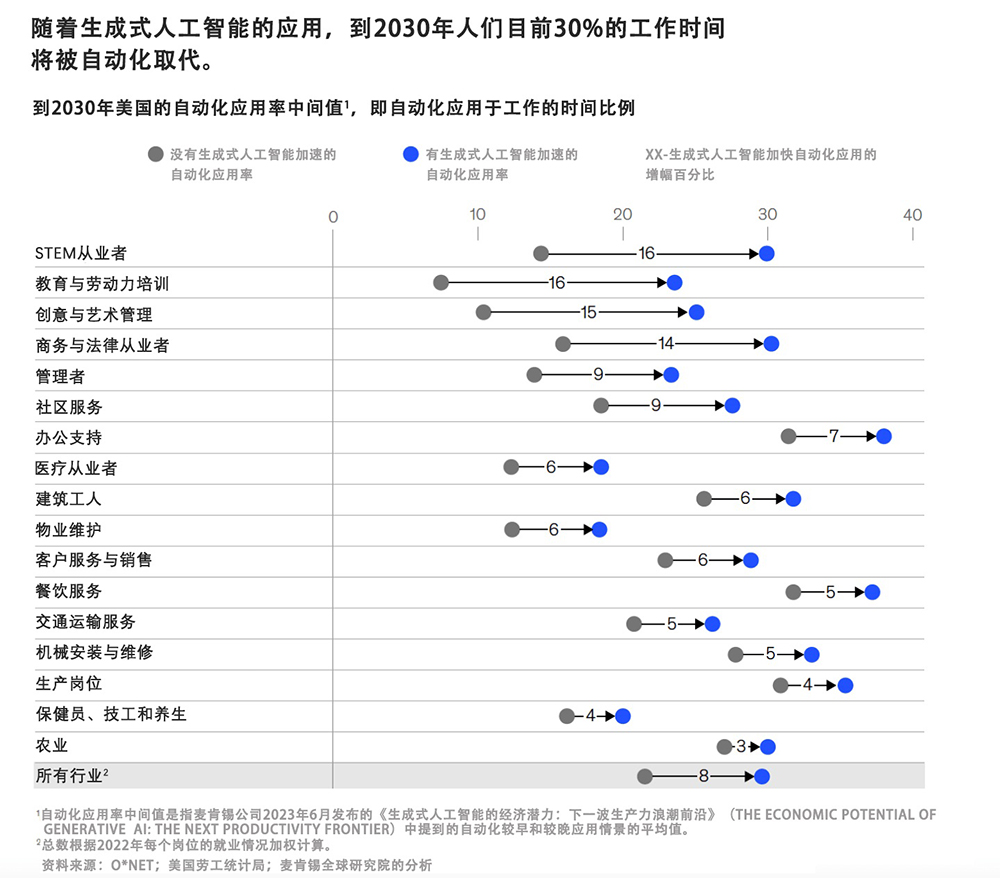
關(guān)于人工智能對勞動(dòng)力的影響,人們分成了兩個(gè)陣營,,有人警告人工智能會(huì)導(dǎo)致大規(guī)模失業(yè),,但有人卻幻想著未來的烏托邦,任何人都可以自由追求自己的夢想,,不需要辛苦從事一份職業(yè),。關(guān)于生成式人工智能具體將如何轉(zhuǎn)變勞動(dòng)力,目前還沒有定論,,但專家和上班族們都認(rèn)為改變不可避免,。
咨詢業(yè)巨頭麥肯錫(McKinsey)新發(fā)布的一份綜合報(bào)告希望通過評估各類工作崗位未來的變化,對這些即將到來的變化進(jìn)行量化,。重要的是,,麥肯錫的研究得出了一個(gè)到目前為止不太常見的觀點(diǎn),那就是從長遠(yuǎn)來看人工智能不會(huì)消滅人類的工作,。盡管這項(xiàng)研究“至少在短期內(nèi)無法明確排除就業(yè)損失的可能性”,。受到生成式人工智能影響最大的行業(yè)可能到2030年依舊會(huì)增加就業(yè)崗位,只是就業(yè)增長速度低于之前的預(yù)期,。
相反,,人工智能會(huì)改變完成某些工作的方式,或者為低薪崗位的員工創(chuàng)造通過接受充分培訓(xùn)從事高薪崗位的機(jī)會(huì),。麥肯錫的報(bào)告估計(jì),,到2030年將有1,200萬人更換職業(yè),比其兩年前的預(yù)測增加了25%,。上班族會(huì)因?yàn)楦鞣N原因更換職業(yè)。有些人可能看到他們的工作崗位消失,,但也有人會(huì)從事更高薪酬的崗位,,或者對他們的技能需求更高的領(lǐng)域。
例如,,麥肯錫認(rèn)為,,醫(yī)療護(hù)理行業(yè)截至4月已經(jīng)有約190萬個(gè)職位空缺,到2030年將新增約550萬個(gè)就業(yè)崗位,。隨著科技行業(yè)以外的公司持續(xù)將人工智能整合到日常運(yùn)營當(dāng)中,,對STEM(科學(xué),、技術(shù)、工程和數(shù)學(xué))工作的需求也將增長23%,。生成式人工智能執(zhí)行行政管理任務(wù)方面的相關(guān)能力,,意味著到2030年對辦公支持和客戶服務(wù)等崗位的需求將分別減少18%和13%。同期內(nèi)對餐飲服務(wù)崗位的需求預(yù)計(jì)也會(huì)下降,,只是下降幅度只有2%,。辦公支持崗位的需求減少對女性的影響尤其明顯,而客戶服務(wù)和餐飲服務(wù)崗位的需求減少尤其會(huì)影響到黑人和拉丁裔員工,。
因此,,現(xiàn)在的挑戰(zhàn)并不是減慢這種下降的趨勢,而是保證上班族為新崗位得到恰當(dāng)?shù)呐嘤?xùn),。麥肯錫建議從高中開始盡早接受STEM領(lǐng)域的培訓(xùn),。麥肯錫還建議公司擴(kuò)大招聘范圍,將失業(yè)者和沒有接受過高等教育的人群包含在內(nèi),,以避免未來招聘時(shí)遭遇挑戰(zhàn),。
對于目前尚未失業(yè)的人們而言,他們的工作性質(zhì)將會(huì)發(fā)生顯著改變,,因?yàn)樗麄?0%的工作時(shí)間將由生成式人工智能自動(dòng)完成,。報(bào)告稱:“重要的是,自動(dòng)化應(yīng)用與工作崗位被淘汰是兩回事,。許多工作崗位的任務(wù)可以在一定程度上改為自動(dòng)化,,這些崗位會(huì)保留下來,但人們?nèi)粘9ぷ鞯男再|(zhì)和工作方式會(huì)發(fā)生改變,?!?/p>

麥肯錫估計(jì),如果沒有生成式人工智能,,現(xiàn)有技術(shù)將把美國員工約22%的工作時(shí)間自動(dòng)化,。而這個(gè)比例之所以能夠提高到30%,可以歸功于ChatGPT,、Bard,、DALL-E和其他工具,因?yàn)樗鼈兡軋?zhí)行需要專業(yè)知識(shí)的任務(wù),,甚至能夠完成以前的技術(shù)無法完成的創(chuàng)意工作,。這將使生成式人工智能成為第一項(xiàng)淘汰知識(shí)工作和低薪崗位的技術(shù)。例如,,律師不需要再審核合同法,,因?yàn)樽匀徽Z言模型可以代替他們完成。[法律人工智能初創(chuàng)公司Casetest在6月以6.5億美元的價(jià)格被湯森路透(Thomson Reuters)收購。]平面設(shè)計(jì)師通常擁有美術(shù)學(xué)位,,至少還有一定的天賦,,但他們可能發(fā)現(xiàn)Midjourney和DALL-E可以減少完成一份插畫需要的草稿數(shù)量。
麥肯錫預(yù)計(jì)會(huì)有1,200萬人更換職業(yè),,這為畢業(yè)生們找到高薪崗位創(chuàng)造了機(jī)會(huì),。麥肯錫的分析估計(jì),將有110萬個(gè)薪酬不超過38,200美元的崗位消失,,但年薪68,700美元的崗位會(huì)增加380萬個(gè),。這并不意味著薪酬最低的崗位不會(huì)受到嚴(yán)重影響。在美國工資水平位于后40%的上班族,,即收入不超過38,200美元的群體,,需要換工作的概率是高收入者的14倍。雖然這份報(bào)告冷冰冰地承認(rèn),,美國一些最低收入崗位不會(huì)受到影響,,因?yàn)楣局Ц兜某凸べY,低于安裝人工智能系統(tǒng)完成這些工作的成本,,但一項(xiàng)統(tǒng)計(jì)數(shù)據(jù)卻證明人工智能可能擴(kuò)大現(xiàn)有的收入不平等,。(財(cái)富中文網(wǎng))
翻譯:劉進(jìn)龍
審校:汪皓
關(guān)于人工智能對勞動(dòng)力的影響,人們分成了兩個(gè)陣營,,有人警告人工智能會(huì)導(dǎo)致大規(guī)模失業(yè),,但有人卻幻想著未來的烏托邦,任何人都可以自由追求自己的夢想,,不需要辛苦從事一份職業(yè),。關(guān)于生成式人工智能具體將如何轉(zhuǎn)變勞動(dòng)力,目前還沒有定論,,但專家和上班族們都認(rèn)為改變不可避免,。
咨詢業(yè)巨頭麥肯錫(McKinsey)新發(fā)布的一份綜合報(bào)告希望通過評估各類工作崗位未來的變化,對這些即將到來的變化進(jìn)行量化,。重要的是,,麥肯錫的研究得出了一個(gè)到目前為止不太常見的觀點(diǎn),那就是從長遠(yuǎn)來看人工智能不會(huì)消滅人類的工作,。盡管這項(xiàng)研究“至少在短期內(nèi)無法明確排除就業(yè)損失的可能性”,。受到生成式人工智能影響最大的行業(yè)可能到2030年依舊會(huì)增加就業(yè)崗位,只是就業(yè)增長速度低于之前的預(yù)期,。
相反,,人工智能會(huì)改變完成某些工作的方式,或者為低薪崗位的員工創(chuàng)造通過接受充分培訓(xùn)從事高薪崗位的機(jī)會(huì),。麥肯錫的報(bào)告估計(jì),到2030年將有1,200萬人更換職業(yè),,比其兩年前的預(yù)測增加了25%,。上班族會(huì)因?yàn)楦鞣N原因更換職業(yè),。有些人可能看到他們的工作崗位消失,但也有人會(huì)從事更高薪酬的崗位,,或者對他們的技能需求更高的領(lǐng)域,。
例如,麥肯錫認(rèn)為,,醫(yī)療護(hù)理行業(yè)截至4月已經(jīng)有約190萬個(gè)職位空缺,,到2030年將新增約550萬個(gè)就業(yè)崗位。隨著科技行業(yè)以外的公司持續(xù)將人工智能整合到日常運(yùn)營當(dāng)中,,對STEM(科學(xué),、技術(shù)、工程和數(shù)學(xué))工作的需求也將增長23%,。生成式人工智能執(zhí)行行政管理任務(wù)方面的相關(guān)能力,,意味著到2030年對辦公支持和客戶服務(wù)等崗位的需求將分別減少18%和13%。同期內(nèi)對餐飲服務(wù)崗位的需求預(yù)計(jì)也會(huì)下降,,只是下降幅度只有2%,。辦公支持崗位的需求減少對女性的影響尤其明顯,而客戶服務(wù)和餐飲服務(wù)崗位的需求減少尤其會(huì)影響到黑人和拉丁裔員工,。
因此,,現(xiàn)在的挑戰(zhàn)并不是減慢這種下降的趨勢,而是保證上班族為新崗位得到恰當(dāng)?shù)呐嘤?xùn),。麥肯錫建議從高中開始盡早接受STEM領(lǐng)域的培訓(xùn),。麥肯錫還建議公司擴(kuò)大招聘范圍,將失業(yè)者和沒有接受過高等教育的人群包含在內(nèi),,以避免未來招聘時(shí)遭遇挑戰(zhàn),。
對于目前尚未失業(yè)的人們而言,他們的工作性質(zhì)將會(huì)發(fā)生顯著改變,,因?yàn)樗麄?0%的工作時(shí)間將由生成式人工智能自動(dòng)完成,。報(bào)告稱:“重要的是,自動(dòng)化應(yīng)用與工作崗位被淘汰是兩回事,。許多工作崗位的任務(wù)可以在一定程度上改為自動(dòng)化,,這些崗位會(huì)保留下來,但人們?nèi)粘9ぷ鞯男再|(zhì)和工作方式會(huì)發(fā)生改變,?!?/p>
麥肯錫估計(jì),如果沒有生成式人工智能,,現(xiàn)有技術(shù)將把美國員工約22%的工作時(shí)間自動(dòng)化,。而這個(gè)比例之所以能夠提高到30%,可以歸功于ChatGPT、Bard,、DALL-E和其他工具,,因?yàn)樗鼈兡軋?zhí)行需要專業(yè)知識(shí)的任務(wù),甚至能夠完成以前的技術(shù)無法完成的創(chuàng)意工作,。這將使生成式人工智能成為第一項(xiàng)淘汰知識(shí)工作和低薪崗位的技術(shù),。例如,律師不需要再審核合同法,,因?yàn)樽匀徽Z言模型可以代替他們完成,。[法律人工智能初創(chuàng)公司Casetest在6月以6.5億美元的價(jià)格被湯森路透(Thomson Reuters)收購。]平面設(shè)計(jì)師通常擁有美術(shù)學(xué)位,,至少還有一定的天賦,,但他們可能發(fā)現(xiàn)Midjourney和DALL-E可以減少完成一份插畫需要的草稿數(shù)量。
麥肯錫預(yù)計(jì)會(huì)有1,200萬人更換職業(yè),,這為畢業(yè)生們找到高薪崗位創(chuàng)造了機(jī)會(huì),。麥肯錫的分析估計(jì),將有110萬個(gè)薪酬不超過38,200美元的崗位消失,,但年薪68,700美元的崗位會(huì)增加380萬個(gè),。這并不意味著薪酬最低的崗位不會(huì)受到嚴(yán)重影響。在美國工資水平位于后40%的上班族,,即收入不超過38,200美元的群體,,需要換工作的概率是高收入者的14倍。雖然這份報(bào)告冷冰冰地承認(rèn),,美國一些最低收入崗位不會(huì)受到影響,,因?yàn)楣局Ц兜某凸べY,低于安裝人工智能系統(tǒng)完成這些工作的成本,,但一項(xiàng)統(tǒng)計(jì)數(shù)據(jù)卻證明人工智能可能擴(kuò)大現(xiàn)有的收入不平等,。(財(cái)富中文網(wǎng))
翻譯:劉進(jìn)龍
審校:汪皓
Discussions of A.I. in the workforce oscillate between alarm bells of mass unemployment and fantasies of a future utopia where everyone is free to pursue their passions instead of grinding out a career. While the particulars of how generative A.I. will transform the workforce may be debatable, experts and workers alike believe that change is inevitable.
A comprehensive new report from consulting giant McKinsey tries to quantify these impending changes by examining how the mix of jobs might change over time. Crucially, McKinsey’s research reaches a point of view that has been uncommon so far in the discourse—that A.I. will not wipe out jobs in the long term. Even though the research in question “cannot definitively rule out job losses, at least in the short term.” The sectors most exposed to generative A.I. could still add jobs through 2030 but at a slower pace than previously anticipated, the report concludes.
Instead, A.I. will either change the way certain jobs are done or create an opportunity for employees in lower-paying jobs to move into high-paying positions, provided they receive adequate training. McKinsey’s report estimates 12 million people will switch careers by 2030, 25% more than it projected just two years ago. Workers will change careers owing to a variety of factors. Though some may see their jobs disappear, others will gravitate toward higher paying fields, or ones where their skills are in greater demand.
For example, health care, which, according to McKinsey, already has an estimated 1.9 million job openings as of April, will add roughly 5.5 million new jobs through 2030. There will also be a 23% increase in demand for STEM jobs, as companies outside the tech industry continue to integrate A.I. into their day-to-day operations. Generative A.I.’s relative competency at performing administrative tasks means demand for jobs like office support and customer service will decline 18% and 13%, respectively, through 2030. Food service can also expect a decline in demand, although at a much lower level of 2% over the same time frame. The reduced job demand in office support roles will disproportionately affect women, while reduced demand in customer service and food service poses outsize risks to Black and Hispanic employees.
The challenge, then, is not so much mitigating these declines as it is ensuring that workers are properly trained for new roles. McKinsey advises starting training as early as high school for STEM fields. It also advises companies to head off eventual hiring challenges by expanding their applicant pools to include unemployed people and those without higher education.
For those who remain in their current jobs, the nature of their work will change dramatically as 30% of their work hours will be automated away by generative A.I. “It is important to note that automation adoption is not the same as eliminating jobs,” the report says. “Many jobs with some automatable tasks will remain, but the day-to-day nature of what people do and how they do it changes.”
McKinsey estimates that without generative A.I. current technologies could automate roughly 22% of work hours among U.S. employees. The increase to 30% can be attributed to ChatGPT, Bard, DALL-E, and other tools’ ability to perform tasks that require genuine expertise, even creativity that previous technologies couldn’t achieve. This would make generative A.I. one of the first technologies to eliminate knowledge work as well as lower paying jobs. For example, lawyers will no longer have to review contract laws, because natural language models could do it for them. (The legal A.I. startup Casetext sold to Thomson Reuters for $650 million in June.) Or graphic designers, who usually have a fine arts degree in addition to at least some natural talent, might find that Midjourney and DALL-E can reduce the number of drafts needed for an illustration.
McKinsey’s anticipated 12 million worker reshuffle presents opportunities for some to graduate into higher paying jobs. McKinsey’s analysis calculates losses of 1.1 million jobs paying $38,200 or less, with a 3.8 million increase in those offering salaries of $68,700 a year. That’s not to say the lowest paid workers won’t be heavily affected. People in the bottom 40% of wage brackets in the U.S., those who earn $38,200 or less, are up to 14 times as likely to need to change jobs. Although the paper makes a chilling admission that some of the lowest paying jobs in the country may be unaffected because it’s cheaper for companies to pay extremely low wages than it is to install an A.I. system to do those jobs—a statistic that gives credence to concerns A.I. would widen existing income inequality.






